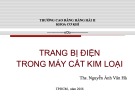
TNU Journal of Science and Technology
229(07): 121 - 132
http://jst.tnu.edu.vn 121 Email: jst@tnu.edu.vn
NON-INTRUSIVE LOAD MONITORING FOR LED LIGHT CLASSIFICATION:
A DATA-DRIVEN MACHINE LEARNING APPROACH
Nguyen Thanh Cong1, Nguyen Ngoc Son1, Dao Ngoc Nam Hai2,
Nguyen Huy Tinh1, Jonathan Andrew Ware3, Nguyen Ngoc An1*
1VNU University of Engineering and Technology, 2VNU Institute of Information Technology
3University of South Wales, United Kingdom
ARTICLE INFO
ABSTRACT
Received:
11/4/2024
Monitoring the operational status of LED lights is important to achieve
energy efficiency and protect user health. Recent studies employed
machine learning and several parameters, such as the LED’s light output
and electrical characteristics, to classify their operational status. However,
under changing environmental conditions, these methods will no longer be
effective, due to the compromise of the environmental noise to the input
data of the models. In this study, we proposed a novel approach to
identifying the operational status of household LED lights using non-
intrusive load monitoring, machine learning models, confident learning,
and the oscillation characteristic of the root-mean-square (RMS) current.
By using the oscillation characteristics of the RMS current, we
significantly reduced the number of inputs to the models and their
computational hardware requirements compared to models using the RMS
current. With the introduction of confident learning, we improved the
prediction accuracy of the models by 2% on average. The models achieved
prediction accuracy ranging from 94% to 97.5%. The proposed method
shows potential in applying to different kinds of electrical devices.
Revised:
10/6/2024
Published:
10/6/2024
KEYWORDS
Non-intrusive load monitoring
(NILM)
LED operational state
classification
Discrete Fourier transform
Confident Learning
Data-centric machine learning
Machine Learning
PHÂN LOẠI TRẠNG THÁI ÁNH SÁNG CỦA ĐÈN LED SỬ DỤNG GIÁM SÁT
TẢI KHÔNG XÂM LẤN VÀ HỌC MÁY HƯỚNG DỮ LIỆU
Nguyễn Thành Công1, Nguyễn Ngọc Sơn1, Đào Ngọc Nam Hải2,
Nguyễn Huy Tình1, Jonathan Andrew Ware3, Nguyễn Ngọc An1*
1Trường Đại học Công nghệ - Đại học Quốc gia Hà Nội, 2Viện Công nghệ Thông tin - Đại học Quốc gia Hà Nội
3Đại học South Wales – Vương quốc Anh
THÔNG TIN BÀI BÁO
TÓM TẮT
Ngày nhận bài:
11/4/2024
Việc theo dõi trạng thái hoạt động của đèn LED có vai trò quan trọng trong việc
sử dụng năng lượng hiệu quả và bảo vệ sức khỏe người dùng. Một số nghiên
cứu gần đây sử dụng học máy kết hợp với một số tham số, như công suất phát
sáng và đặc tính điện, nhằm phân loại trạng thái hoạt động của đèn LED. Tuy
nhiên, trong điều kiện môi trường thay đổi, các phương pháp này sẽ không còn
hiệu quả do ảnh hưởng của nhiễu môi trường đến dữ liệu đầu vào của mô hình.
Trong nghiên cứu này, chúng tôi đề xuất một phương pháp mới để xác định
trạng thái hoạt động của đèn LED gia dụng bằng cách sử dụng giám sát tải
không xâm nhập, kết hợp cùng với học máy và học tự tin. Bằng cách sử dụng
các đặc tính dao động của dòng RMS, chúng tôi đã giảm đáng kể số lượng đầu
vào cho các mô hình học máy và yêu cầu phần cứng của chúng nhằm thực hiện
tính toán so với các mô hình sử dụng dòng RMS. Với việc bổ sung thêm
phương pháp học tập tự tin, độ chính xác dự đoán của các mô hình được cải
thiện thêm trung bình 2%. Các mô hình học máy đạt độ chính xác trong việc dự
đoán dao động từ 94% đến 97,5%. Phương pháp đề xuất cho thấy tiềm năng áp
dụng cho các loại thiết bị điện khác nhau.
Ngày hoàn thiện:
10/6/2024
Ngày đăng:
10/6/2024
TỪ KHÓA
Giám sát tải không xâm nhập
Phân loại trạng thái hoạt động
của đèn LED
Biến đổi Fourier rời rạc
Học tự tin
Học máy hướng dữ liệu
Học máy
DOI: https://doi.org/10.34238/tnu-jst.10115
* Corresponding author. Email: ngocan@vnu.edu.vn















